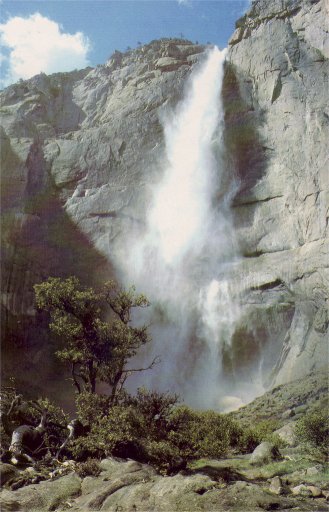
[click to enlarge]
| Online Library: | Title | Author | California | Geology | History | Indians | Muir | Mountaineering | Nature | Management |
Yosemite > Library > Four Seasons of Yosemite > Spring >
Next: Summer • Contents • Previous: Winter

[click to enlarge] |
The approach of spring in Yosemite is seen first in the increasing volume of the waterfalls. The warming sun of late March and early April particularly affects the flow in Yosemite Fall, which is on the sunny, warm side. Its roar begins to echo across the upper Valley as it tunes up for the full symphony of springtime. In this photo, the winter’s ice cone is still visible through the mist, but it is being worn away steadily by the relentless pounding of the water, increasing day by day.
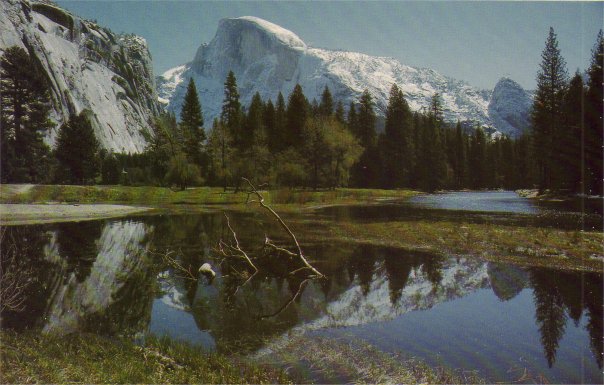
[click to enlarge] |
Half Dome looms serenely above the Valley Floor, which is responding to spring’s approach as the Merced River rises and the adjacent meadows turn green. Recently mantled in snow, the bright silhouette against the sky symbolizes winter’s last stand.
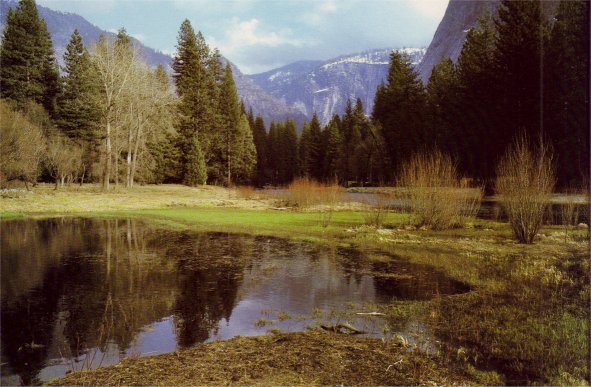
[click to enlarge] |
An early spring landscape in Yosemite Valley features the fresh greenery of emerging grasses and sedges, while tall cottonwood trees and small willows yet rise in lacy silhouettes, awaiting later leaf development. The mellow light of an April afternoon reveals distant cliffs rimmed with snow. Glacier Point soars darkly out of the scene on the right.
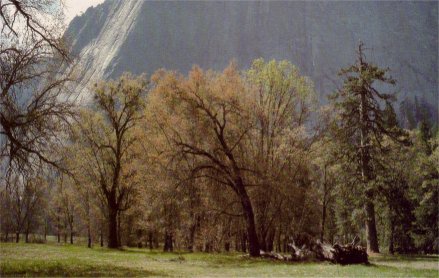
[click to enlarge] |
(Above)
When early May brings a succession of softly-lighted
spring mornings, Yosemite’s meadows reveal one of their
most beautiful aspects. Then, the groves of black oaks
which stand in many of the meadows are clothed in the
most delicate of tones for the brief period of leaf
emergence. Muted reds, greens and golds weave a misty
tapestry across these great trees, particularly striking as
seen against the background of blue-gray cliffs. The
fleeting quality of this display only olds to its haunting
beauty. Our scene is in El Capitan Meadow, with
Middle Cathedral Rock as a backdrop.
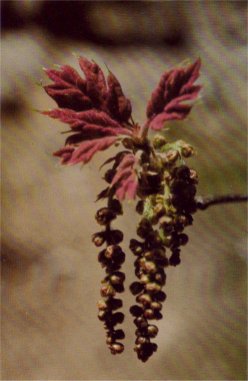
[click to enlarge] |
(Right)
In close-up, the origin of the black oaks’ colorful spring
display is seen clearly. The tiny new leaves emerge as
a bright scarlet tone, while the lace-like pollen catkins
which are sprinkled liberally along the branches are
colored in shades of gold. This striking blend of springtime color is enhanced by the new green of the
developing leaves as they begin to enlarge.
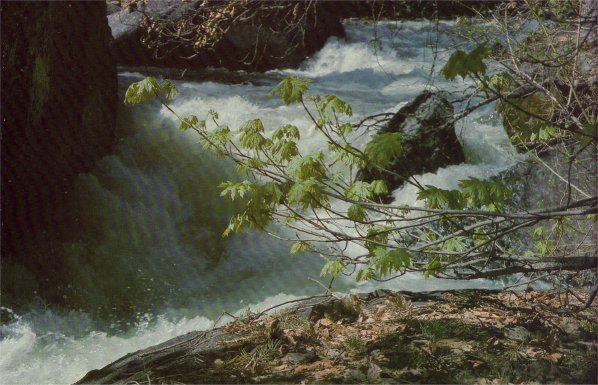
[click to enlarge] |
The sound of springtime is, in essence, the rush of water from its source in the deep snow fountains of the High Country down toward the sea. Everywhere, the streams are outlined with white water, singing their way onward with unceasing vitality. Graceful branches of the big-leaf maples bend over the surface, their newly-opened leaves a rich chartreuse in tone.
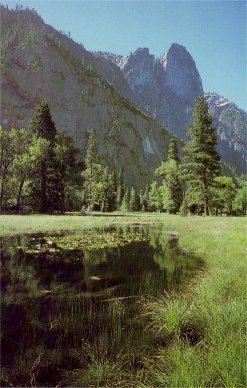
[click to enlarge] |
As the snow melt from the High Country reaches its peak— sometime during May—the Merced River rises dramatically. In more level areas of the Valley Floor, it broadens to the proportions of a slender lake, often engulfing generous portions of its banks. Temporarily, willows, alders, cottonwoods and other streamside trees stand in the swirling current, swaying gracefully as in a gentle breeze. Afternoon light plays across Half Dome, outlining it sharply against a soft spring sky.

[click to enlarge] |
Another familiar aspect of springtime is the rising of the water table under Yosemite Valley’s meadows, as the descending moisture from the snow-melt above saturates the ground. The result is the filling of small meadow basins to create mini-lakes or reflection pools which mirror the tremendous scenery around them. As these pools disappear quietly in early summer, wildflowers follow their receding patterns into the dampness. This pool, with Sierra pond lilies floating on its quiet surface, has for a backdrop the 3000-foot north face of the Sentinel Rock.
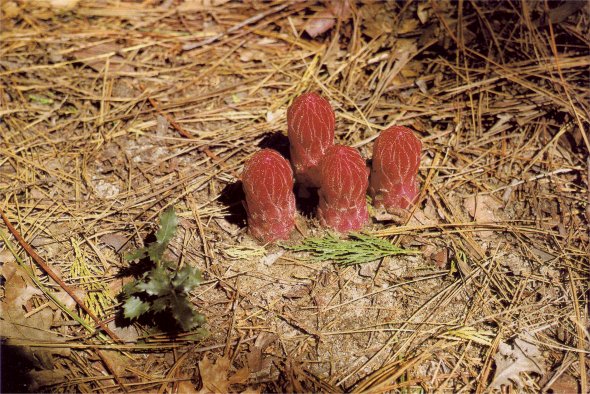
[click to enlarge] |
The unusual snow plant (Sarcodes sanguinea) is one of spring’s most treasured discoveries. Rising through the pine-needled floor in May like a blood-red stalk of asparagus, it is completely without the green hues so common to the rest of the plant world. Thus, lacking chlorophyll, it is unable to produce its own food as most plants do and must depend for sustenance on decaying vegetation beneath the forest floor. It seems exotic and unreal, yet invariably fascinates with its striking form and color. The snow plant is never abundant, but every spring offers a few of them. No matter how often one has seen them in the past, it is always thrilling to find once again the first snow plant of another springtime.
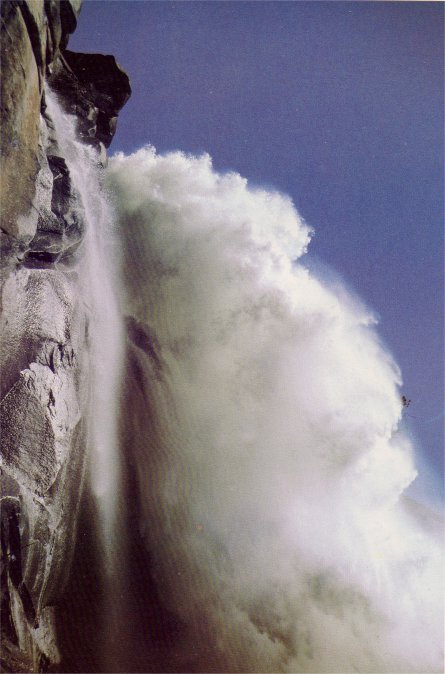
[click to enlarge] |
(Right)
More than any other feature of Yosemite, its overpowering waterfall display seems the
very essence of springtime’s glory. As the melting snow from the High Country
rushes down toward the sea, streams pour over the great walls of the Valley to meet
the Merced River, flinging themselves into the air to create rockets of white water
which seem to emerge from the sky itself. In years of heavy snowfall, their roar
literally fills the Valley. Nevada Fall, 596 feet in height, is seen in this photo,
surging over the upper cliff of the Giant Stairway.
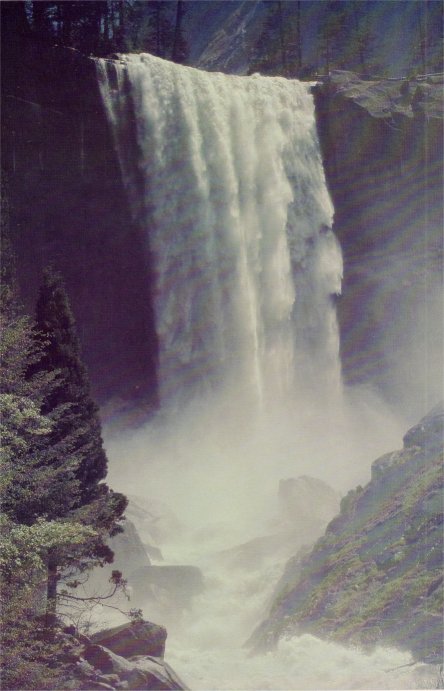
[click to enlarge] |

[click to enlarge] |
(Left)
Vernal Fall, 317 feet in height and nearly 80 feet wide at peak volume, constitutes the lower
step on the Giant Stairway. The well-known Mist Trail enables the hiker—climbing through
the driving spray of the fall itself—to reach its top from Happy Isles, a distance of one and a
half miles and a vertical rise of about 1200 feet. All of Yosemite’s waterfalls reach their peak
during May; however, good displays in most of the falls will be seen in normal years from
mid-April to the latter part of June.

[click to enlarge] |
Bridalveil Fall, 620 feet high, is located at the extreme western end of Yosemite Valley and thus is the first of the great waterfalls to be seen by most visitors. Pouring out of its hanging valley between the Cathedral Rocks and the Leaning Tower, it crashes into the granite below, forming vast clouds of spray. This in turn is lifted by the unseen hands of the wind as a filmy veil and spread across the cliff in ever-changing patterns of lace-like delicacy. It is literally a plaything of the winds and is capable of innumerable forms and moods as the lights and shadows evolve. Bridalveil has a dependable watershed, draining the basin around Ostrander Lake; thus it runs, albeit in diminished volume, throughout the year.

[click to enlarge] |
Dogwood is easily the favorite blossom of those who come to savor the special charms of Yosemite’s springtime. These elegant blooms come at the same time as the peak of the waterfalls—the month of May—though the earliest are found in late April and they linger on into June at higher elevations. Well distributed across the Valley Floor wherever there is adequate moisture, dogwood is especially abundant near Fern Spring and in the area of Happy Isles. The western dogwood (Cornus Nuttallii) usually consists of a pattern of six petal-like bracts surrounding the actual flower-head itself, though groupings of four or five can be seen too. The size of the entire blossom is frequently an astonishing six inches in width.
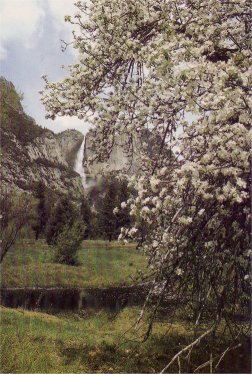
[click to enlarge] |
(Left)
Back in the 1860’s, three apple orchards were planted in Yosemite
Valley and after more than a century they still add the delicate
beauty of their blossoms to a memorable day in springtime.
Normally, these apple trees flower in late April, just before the
dogwood comes into its prime. Occasional trees appear up and
down the Valley, where seeds have been carried by birds or
animals. Their spring blossoms bring a unique pictorial
foreground to many a vista of cliffs and waterfalls, such as this
scene with Yosemite Fall as its central theme.

[click to enlarge] |
Most famous of all Yosemite’s waterfalls is the one which carries the name of the Park itself —Yosemite Falls. Correctly referred to as “Falls,” it consists of three increments—the 1430 foot sheer drop of the Upper Fall, the 675 foot descent through the tortuous, twisting Inner Gorge and the 320 foot plunge over the Lower Fall. This total of 2,425 feet from rim to Valley Floor makes it the second highest known waterfall on earth. Only Angell Fall in Venezuela is known to be higher—about 3,200 vertical feet in total height. The Lower Fall, seen in this photo, is easily approached by a short trail near Yosemite Lodge. At peak volume—in May—the scene is a wild blending of white water, dark rock, driving mist and the all-pervading roar and clamor of the furious stream. At the time of the full moon in May, when the waterfall fills this grotto with mist, an ethereally beautiful lunar rainbow spans the chasm for three or four nights.
Next: Summer • Contents • Previous: Winter
| Online Library: | Title | Author | California | Geology | History | Indians | Muir | Mountaineering | Nature | Management |
http://www.yosemite.ca.us/library/four_seasons/spring.html